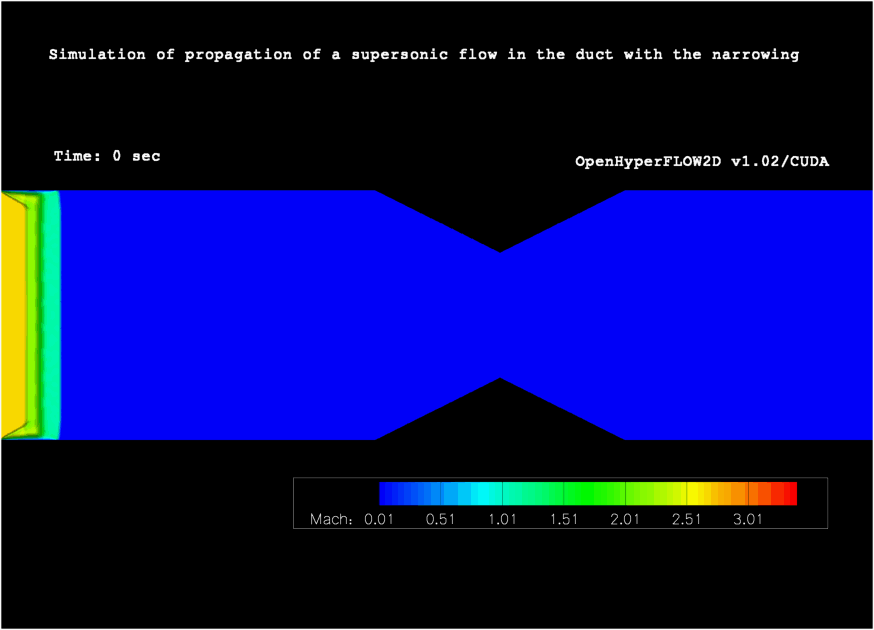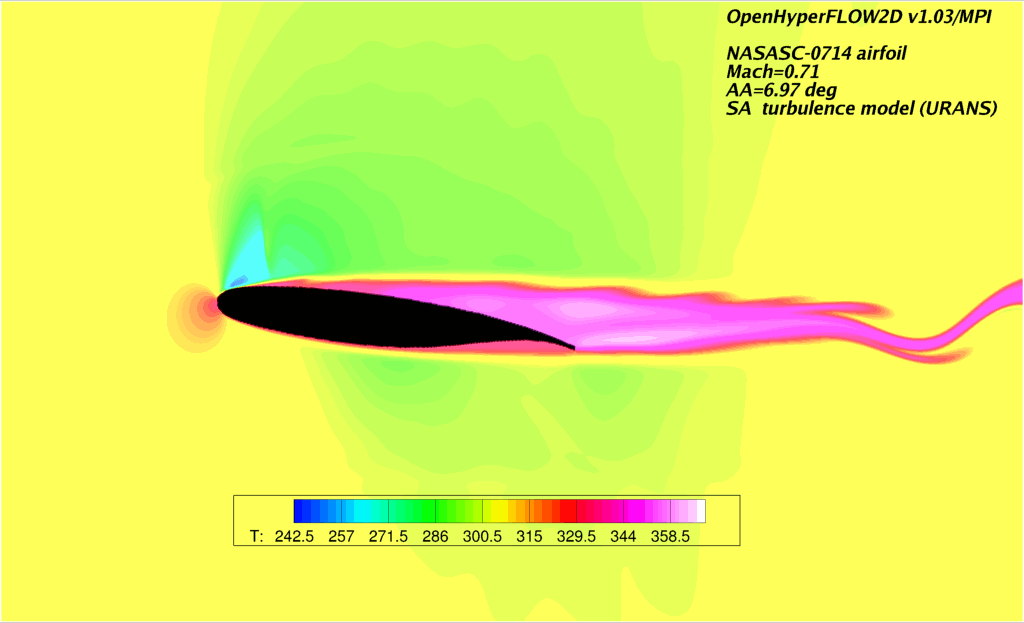Computational Core of HyperFLOW2D now open source, meet OpenHyperFLOW2D !
Tags cfd, open source, parallel
Computational Core of my oldest 2D NS-solver now open source (LGPLv3),
meet OpenHyperFLOW2D
(include serial and parallel MPI,OpenMP and CUDA versions)



meet OpenHyperFLOW2D
(include serial and parallel MPI,OpenMP and CUDA versions)



Total Comments 7
Comments
-
 i am doing simillar work.
i am doing simillar work.
can you tell me what initial & boundary conditions did you use?
Also plz just which flow model you used??Posted July 12, 2015 at 00:06 by Mehlam 
-
 I do not quite understand your question. What do you mean by this case, "similar work"? The models, which are used in my code are briefly described in the wiki. Or you mean a picture with a Nozzle case that is show as an illustration?Quote:
I do not quite understand your question. What do you mean by this case, "similar work"? The models, which are used in my code are briefly described in the wiki. Or you mean a picture with a Nozzle case that is show as an illustration?Quote:Posted July 12, 2015 at 06:47 by SergeAS 
-

Boundary conditions
Yes i saw your supersonic nozzle picture.
I am also trying to design a supersonic nozzle with a Exit Mach of 3.0
but the results we diverging .
I used BC as (Inlet-Pressure of 300000 P , Oulet pressure BC - 0 P , walls as stationary )
so wanted to know your BC's and model setup details of how did you specify inlet , outlet and walls and did you use freestream conditions in the surrounding?
hope you can help and this clearifies your question.
and if you can share me your Email, i can send you picture showing geometry i am working on. (tried attaching picture over here but failed)
Regards,
Mehlam.Posted July 12, 2015 at 15:02 by Mehlam 
-
 Well, first of all it is necessary to agree on the terms.
Well, first of all it is necessary to agree on the terms.
I do not know which solver you use. So let's start with their classification.
At first:
Solvers are dimensional and dimensionless. Most solvers dimensionless. In contrast OpenHyperFLOW2D - originally the dimensional solver as its core code was created for the engineering design. That is, all the differential equation in this case are written in dimensional form.
Secondly:
Solvers are use the concept of a gauge pressure (p_g) and using the absolute pressure directly. In case of gauge pressure concept, to obtain the absolute pressure we should add gauge pressure to the pressure, which operates solver.
OpenHyperFLOW2D initially uses the concept of absolute pressure directly
Next point, the physical aspect of your case.
When you say "Oulet pressure BC - 0 P" it means outflow in the vacuum ?
In my case outflow occurs in the atmosphere,
that is equal to the ambient pressure 1.0e5 Pa
If your solver uses the concept of a gauge pressure then your BC can mean both.
It depends on the value of gauge pressure:
p_g = 0 Pa -> vacuum outflow
p_g = 1.e 5 Pa -> atmosphere outflow
In the case of outflow in vacuum instability is normal. In this case, usually zero pressure replace a very small non-zero,
but not everyone solver can be considered this (OpenHyperFLOW2D can)
Now concerning the the initial and BC of the above case:
Since the problem of axially symmetric, simulated only half the nozzle.
Image obtained with a full nozzle in the postprocessor.
BC:
- X- axi - symmetry BC (radial velocity and gradients of all parameters is zero)
- left boundary in chamber - Dirichlet BC with total pressure 7.2e6 Pa and total temperature 3338.5 K.
concentration of combustion products - 100%, air - 0%
- left boundary in ambient area - Dirichlet BC with total pressure 1.0e5 Pa and total temperature 300 K.
concentration of combustion products - 0%, air - 100%
- top boundary - Dirichlet BC with total pressure 1.0e5 Pa and total temperature 300 K.
concentration of combustion products - 0%, air - 100%
- right boundary - Neumann BC with zero gradient in axial direction
- nozzle walls - "no-slip" BC
Initial conditions:
- chamber from left boundary to throat filled gas with total pressure 7.2e6 Pa and total temperature 3338.5 K.
concentration of combustion products - 100%, air - 0%
- another domain part is filled gas with total pressure 1.0e5 Pa and total temperature 300 K.
concentration of combustion products - 0%, air - 100%
The boundary between the domains simulates a frangible disc in throat of nozzle.
So as not to attract attention spambots I do not give here my e-mail, but you can easily find it in any files header of OpenHyperFLOW2D projectPosted July 13, 2015 at 04:52 by SergeAS 
-
 Sir m working on nose cone with mach number 7.5 at 20km altitude from ground level. i calculate stagnation pressure,total temperature at 20km altitude but in boundary condition there is total pressure and supersonic/initial gauge pressure. I am confused in initial gauge pressure bacause when i calcualte it comes negative.My stagnation pressure is27846819.76pa at 20km altitude tempt.is 216.5k and absolute pressure is 5529 pa so what i take initial gauge pressure?
Sir m working on nose cone with mach number 7.5 at 20km altitude from ground level. i calculate stagnation pressure,total temperature at 20km altitude but in boundary condition there is total pressure and supersonic/initial gauge pressure. I am confused in initial gauge pressure bacause when i calcualte it comes negative.My stagnation pressure is27846819.76pa at 20km altitude tempt.is 216.5k and absolute pressure is 5529 pa so what i take initial gauge pressure?Posted October 22, 2016 at 06:12 by digvijaypatil 
-
 sir what can i take as total temperature it will be stagnation tempt.or tempt.at 20km altitude. my stagnation tempt.is 2658.25k and tempt.at 20km altitude is 216.5k
sir what can i take as total temperature it will be stagnation tempt.or tempt.at 20km altitude. my stagnation tempt.is 2658.25k and tempt.at 20km altitude is 216.5kPosted October 22, 2016 at 06:21 by digvijaypatil 
-
 Total pressure and temperature in this case is calculated on the assumption that the expansion of the gas flow reaches 7.5 Mach velocity and static pressure and temperature will match your predetermined altitude. Typically in CFD codes this calculation is done automatically using the formula for adiabatic expansion of gasQuote:
Total pressure and temperature in this case is calculated on the assumption that the expansion of the gas flow reaches 7.5 Mach velocity and static pressure and temperature will match your predetermined altitude. Typically in CFD codes this calculation is done automatically using the formula for adiabatic expansion of gasQuote:
e.g. in OpenHyperFLOW2D for your case
Mach=7.5 U=2737.31 m/sec T=216.7 K p=5529 Pa p*=2.78713e+07 Pa T*=2863.29 KPosted October 22, 2016 at 12:48 by SergeAS 







